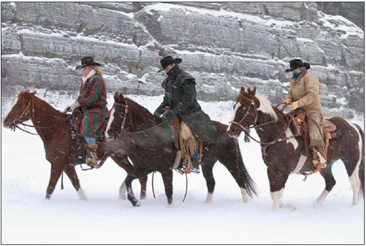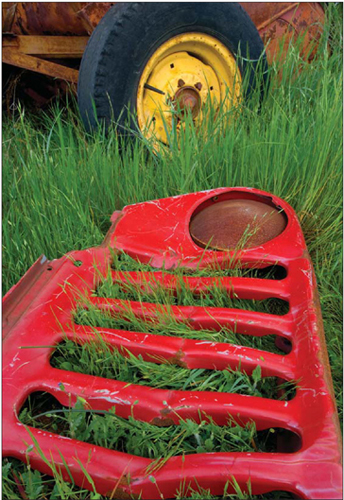CHAPTER 16:
PUBLIC RELATIONS
Public relations, or PR, is all about community — your city community, your professional community, and your neighborhood or merchant community. By getting your business involved in all of these communities, you get to do some good works, get the story out about your business, network and get face time with potential clients, and weave your history into the history of these various communities.
HIRING A PR FIRM
When you hire a PR firm, you get to take advantage of all of their contacts. And that old cliché — it's not what you know, it's who you know — proves itself true.
IT BOILS DOWN TO RELATIONSHIPS
I can write a press release as good as the best of them. But all my best exposure (local newspapers, speaking engagements and magazines) has always come through PR guys, not through solo efforts.

A stock photo by Jim Miotke.
PR people have established relationships with reporters, editors, club presidents and often local politicians. Tribalism is simply human nature: We take care of our own. People are much more likely to do a story, engage a speaker or promote a cause if it's connected to someone they know. When you hire a PR guy, his friends are your friends. It's a pretty slick arrangement, but professional PR help doesn't come cheap. Since the goal is to make contacts — to plant seeds, as commercial shooter Patrick Fox says — it's more difficult to track the results than it is from your website or an e-mail promotion. That doesn't mean it's not a good investment, though.
THE PLACE WHERE STORIES ARE BORN
Pick up your local newspaper and look at the business section. You'll see articles featuring local businesses. Each story has a different spin — i.e., the angle through which the story is approached. They may be about women in business, or small companies with unusually large growth rates, or successful franchisors. Now look at the variety section: You'll see stories about local moms who have turned their hobby of recycling used mittens into teddy bears into businesses grossing $2 million a year, profiles about local children's book authors and illustrators, or stories about local organic farmers.
I used to think there were ambitious reporters out pounding the pavement, researching their local markets to ferret out these stories. I was wrong: PR people pitch these stories to the reporters and editors. The reporters don't go out to find the stories — the stories find them. That means if you want to have a story written about yourself or your business, it would behoove you to have a professional to pitch it.
HOW TO FIND A GREAT PR PROFESSIONAL
Just as when you're shopping for any other professional service, get referrals. Word of mouth is not only the best way to build your business, it is the best way to find other people to do business with. Ask for references and follow up on them. Make a few phone calls and see what kind of goodwill the PR professional has generated for himself among his own clients.
DOING IT YOURSELF
It's possible to do your own PR and get adequate results, but you'll have to be self-motivated. Just as it's difficult to track the results of a hired gun, it'll be difficult to track your own. Be prepared to work hard to make connections — whereas a professional PR person already has contacts at every local newspaper, magazine and professional organization, you're an unknown entity and will have to seek out contacts of your own.

A macro nature shot by Lewis Kemper.
A hired PR person can pick up the phone and call the editor-in-chief at Townsville Magazine and say, “Hey Brian, how've you been? How does Petey like going to college in Boulder? I've got a really interesting local photographer I'd like you to meet, and I want to show you her work. Her studios have set a new industry standard, and I think there's a story here that your readers would be very interested in.”
This call is going to go very differently if you make it yourself.
“Hello, this is Vik Orenstein, may I speak to Brian Jackson, editor-in-chief, please?”
“One moment, please.” Then you're connected to his voice mailbox. You struggle to think of a message that doesn't sound dopey.
“Oh, hi, this is Vik Orenstein, I'm a local photographer — I own KidCapers and Tiny Acorn Portrait Studios. I'd like to show you my work and discuss a story I think your readers may have an interest in.” If you're lucky, your call will be returned — by his personal assistant — who will inform you that you need to contact the story editor. So you will contact the story editor, who will tell you that the person you really need to speak to is the photo editor, who's out of town until after the end of the month.

A travel image by David Sherman.
If your timing is excellent and the magazine is hungry for stories, you'll most likely be asked to send a query letter, or proposal, before you get any face time with anyone.
So you can see that being your own PR professional can be done, but it's not the most efficient route. I've learned this from experience.
Nevertheless many photographers starting their own businesses can't afford to hire someone for PR. Here are the tools you need to get the word out and connect with your community.
PRESS RELEASES
Press releases are very brief announcements that are sent to newspapers and magazines to cultivate stories about your business. They're easy to write. Max Fallek, of Fallek and Associates Public Relations, outlines the elements of a basic press release:
Centered at the top in bold, in 16- to 18-point font, write the words: NEWS RELEASE.
Below that and flush left, include a line that tells the recipient when the story should be released. For example, FOR IMMEDIATE RELEASE or FOR RELEASE JUNE 1, etc.
Directly across from the release date, flush right, include a line that says, “For further information,” with a contact name, phone number and e-mail address.
Next, flush left, place the headline. The headline should never extend past the center of the page, so if it's longer than half a page, go back to the left and add a second line directly underneath the first. The headline should never be more than two half lines long.
Below the headline, flush left, write a line that tells where the story originated, i.e., Minneapolis, Minnesota.
Double-space the body of the story, with three to four spaces between paragraphs. A press release should never be more than one and a half pages long.
Whenever possible, a photo should be sent along with the press release, with a caption running along the bottom describing the subject(s), e.g., “Stanley Kowalski, owner of Streetcar Named Desire Photography Studio.”
“You can write your own press releases and have some success at it if you remember two things,” Fallek says. “You have to have a great headline. It should be a real attention-getter, it should be bold. And second, you should be fearless! Publications need you more than you need them — they have to have stories or they're out of business.”
Where to send your press releases? Standard Rate and Data Service (www.srds.com) and Cision (http://us.cision.com) both list every periodical publication in the country.
Of course, nowadays you can send press releases via e-mail, but queries should still be sent snail mail. Not every decision maker accepts press releases via e-mail, and there's always the danger of getting caught in the spam filter.
PRESS KITS
Once you've gotten a few articles, speaking engagements and publications under your belt, you might want to put together a press kit. A press kit is like a press release on steroids. Rather than a single page announcing one event or story angle, a press kit is a folder (embossed with your logo or sporting a sticker with your logo) which contains the following:
copies of recent articles written about you, your business, or that you have written for publication;
photos of you, your place of business and/or any recent newsworthy special events you/your business has hosted;
your biography (one half to one full page), which should include a list of any public speaking, charitable and pro bono work you've done;
your business card and your PR person's business card tucked into precut slots on the pocket of the folder;
a one page or less time-sensitive press release of the type described above.
CHARITABLE ACTIVITIES
A great way to generate a good buzz about yourself and your business is to sit on a board for a charitable organization. Try to find a charity that affects your client base. If you are a family photographer, look for an organization like a crisis nursery or a children's hospital — a charity that makes life better for families.
“Yeah right, in all that spare time I've got,” you're probably thinking. “Maybe I'll just make a donation.” While a donation is better than nothing, remember that your main goal is to make contacts, to network, to get to know people and let them get to know you. A donation gets your business name out there, but heading up the decoration committee for the annual ball or editing the newsletter will get you out there personally, where you can connect with people and those people can put a face with your name.
PUBLIC SPEAKING
Speaking to groups and organizations also helps you make connections and promote your business. Not only do people see your face, they hear your message.
Public speaking can be a challenge. I enjoy public speaking about as much as I enjoy putting a lighted sparkler up my nose and twirling it around. Perhaps I exaggerate. It's the anticipation of the public speaking and not the act itself that I can't stand. Beginning about three days before any such engagement, I fret. I sweat. I worry. I get stomachaches. I practice my delivery and fret some more. The morning of the engagement I mentally berate myself for getting into such a horrible situation.

An action portrait by Chris Darbonne.
But then I get to the hotel conference room, or ballroom, or church basement, or women's club, or wherever the meeting is held. I see all the faces — friendly faces — and I relax a little. Then I start my speech with a joke and I get a laugh (which is one of the things I live for), and suddenly I'm having fun. My cottonmouth miraculously goes away, my lips stop sticking to my teeth and when it's all over I think, “Gee, that wasn't so bad.” If you share my secret shame — the unnecessary fear of public speaking — there is help for you. Toastmasters International, among other groups, can help you overcome the fear of opening your mouth and winding up with one of your feet in it. Rest assured overcoming your hesitation will benefit your business.
PROFESSIONAL GROUPS
Instead of just speaking to professional groups, you could actually join one. Pick a group that has members from all different industries and businesses. That way, not only will your fellow members think of you when they need photographs, you'll be able to choose someone who you know and trust next time you need a CPA, a lawyer or a PR person.

A stock photo by Kerry Drager.
PRO BONO WORK
Doing pro bono gives something back to the community that's helped make your business a success. As a photographer, your work can be used in annual reports, promotional material, newsletters, posters, press releases and even wall art. Again, choose charitable organizations that serve in areas complementary to your specialty. If you're an architectural photographer, shoot pro bono for a group that advocates for the preservation of landmark buildings. If you're a nature shooter, do something pro such as shooting a local landscape bono for a conservancy group, such as shooting a local landscape destined to become a strip mall.
There are different ways to become involved in your community, generate some goodwill for your business and do some good deeds in the bargain. Whether you go it alone or hire a professional, the benefits will be many.
